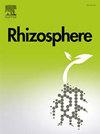Rhizobacteria provide resistance to Gaultheria mucronata (Ericaceae) against seasonal variability in volcanic scoria soils
IF 3.5
3区 生物学
Q1 PLANT SCIENCES
引用次数: 0
Abstract
Plants growing in volcanic scoria soils face severe edaphic challenges, including nutrient scarcity, high porosity, and marked seasonal variability. This study explores the structural and functional stability, microbial interactions, and plant growth-promoting capacities of rhizosphere bacterial communities associated with Gaultheria mucronata (L. f.) Hook. & Arn. (Ericaceae), a native shrub adapted to extreme environments in southern Chile. Rhizosphere and bulk soil samples were collected in contrasting seasons (summer and winter) across two volcanic scoria sites. By employing 16S rRNA metabarcoding, functional inference, microbial isolation, and plant-beneficial trait assays, we demonstrated that rhizosphere bacterial communities maintain structural stability and distinct functional profiles, significantly differentiated from bulk soils despite seasonal fluctuations in soil nutrient availability. Network co-occurrence analyses revealed season-dependent patterns, with higher complexity and balanced interactions in winter. Functional predictions highlighted enrichment in rhizosphere processes related to nutrient mobilization, organic matter degradation, and antioxidant mechanisms. Arthrobacter sp. emerged as a keystone taxon with consistent high abundance, central network positioning, and multiple plant growth promoting traits, including phosphate solubilization, siderophore production, and ammonia synthesis. Our findings demonstrate that rhizosphere bacterial communities associated with Gaultheria mucronata maintain structural stability and exhibit functional plasticity across contrasting seasons in nutrient-poor volcanic scoria soils. These traits reflect the resistance of rhizobacteria to seasonal variability and suggest a role in supporting plant adaptation to extreme edaphic environments.
根瘤菌在火山渣土中提供了对高卢菌(Ericaceae)对季节变化的抗性
在火山渣土中生长的植物面临着严峻的土壤挑战,包括养分缺乏、高孔隙度和显著的季节变化。本研究探讨了高卢菌(Gaultheria mucronata, l.f .)根际细菌群落的结构和功能稳定性、微生物相互作用以及植物生长促进能力。钩。,在攻击。(Ericaceae),一种适应智利南部极端环境的本土灌木。根际和大块土壤样本在两个火山渣地的不同季节(夏季和冬季)收集。通过16S rRNA元条形码、功能推断、微生物分离和植物有益性状分析,我们证明了根际细菌群落保持结构稳定性和独特的功能特征,尽管土壤养分有效性存在季节性波动,但与普通土壤有显著差异。网络共现分析显示季节依赖模式,在冬季具有更高的复杂性和平衡的相互作用。功能预测强调了与养分动员、有机物降解和抗氧化机制相关的根际富集过程。节肢细菌是一个重要的分类单元,具有一致的高丰度、中心网络定位和多种促进植物生长的特性,包括磷酸盐增溶、铁载体生产和氨合成。我们的研究结果表明,在营养贫乏的火山渣土中,与高卢菌相关的根际细菌群落在不同季节保持结构稳定性并表现出功能可塑性。这些特征反映了根杆菌对季节变化的抗性,并表明在支持植物适应极端土壤环境中起作用。
本文章由计算机程序翻译,如有差异,请以英文原文为准。
求助全文
约1分钟内获得全文
求助全文
来源期刊

Rhizosphere
Agricultural and Biological Sciences-Agronomy and Crop Science
CiteScore
5.70
自引率
8.10%
发文量
155
审稿时长
29 days
期刊介绍:
Rhizosphere aims to advance the frontier of our understanding of plant-soil interactions. Rhizosphere is a multidisciplinary journal that publishes research on the interactions between plant roots, soil organisms, nutrients, and water. Except carbon fixation by photosynthesis, plants obtain all other elements primarily from soil through roots.
We are beginning to understand how communications at the rhizosphere, with soil organisms and other plant species, affect root exudates and nutrient uptake. This rapidly evolving subject utilizes molecular biology and genomic tools, food web or community structure manipulations, high performance liquid chromatography, isotopic analysis, diverse spectroscopic analytics, tomography and other microscopy, complex statistical and modeling tools.
 求助内容:
求助内容: 应助结果提醒方式:
应助结果提醒方式:


